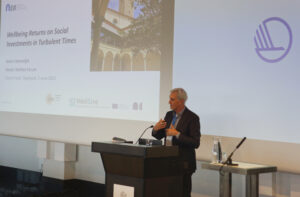The Nordic welfare model: Strong public foundations for a productive private sector
Välfärdspolitik
7 sep 2023
The Nordic welfare state is an economic asset, not a liability, contrary to common misconceptions. Professor Anton Hemerijck emphasises its resilience during crises, and its ability to compete globally. This article is based on a presentation held at the Nordic Welfare Forum 2023 in Reykjavik.
During the 1980s and 1990s, a belief permeated the social sciences: countries with significant welfare expenditure can’t be economically competitive. Anton Hemerijck, Professor of Political Science and Sociology at the European University Institute in Florence, wishes to dispel this notion.
– It wasn’t true then, and it isn’t true now. But it did become the dominant view in sociology, political science, and economics.
One of the key points Professor Hemerijck emphasises is the fact that countries that score high on poverty alleviation and competitiveness tend to have high employment rates. This can be achieved in different ways. Both Sweden and the US had very high employment in the 1990s, the former through a state-led Nordic route, and the latter through a liberal route. According to Hemerijck, the Swedish, and broader European model, proved more resilient.

– In the wake of the Great Recession of 2007–2009, employment rates in the US fell sharply, despite a much stronger fiscal response than in Europe. President Barack Obama nurtured industries and rescued banks, whilst Europe was all about austerity.
The reason why the US model failed to respond, even when stimulated, lies at the heart of the political system.
– In a highly deregulated labour market like the US, men can hold three jobs while women, due to the high cost of childcare, stay at home, Hemerijck explains.
The competitive components of the Nordic welfare state
Nordic welfare states prioritise investment in their citizens from the outset. By allocating resources to childcare benefits, female employment increases, thus making society more resilient in a crisis. And through solid educational policies, children are given a strong start in life.
– In terms of fiscal sustainability, the Nordics do relatively well because they spend a lot on public services such as social assistance and unemployment insurance, Hemerijck argues.
Unlike the more pension-focused welfare states of Southern Europe, the Nordic welfare states invest in their citizens throughout their careers.
– It is not simply about redistribution. The Nordic welfare state provides an insurance policy when a crisis hits.
Professor Anton Hemerijck lists the different kinds of insurances the Nordic welfare state provides its citizens: Robin Hood solidarity guarantees a minimum income regardless of wealth, Piggy Bank solidarity provides support during contingencies, Stepping-Stone solidarity ensures equal access to quality services. By stabilising the macro-economy during recessions, the welfare state strengthens its ability to recover.
A bedrock for a booming private sector
While the public sector in isolation can’t maintain productivity, Professor Hemerijck posits that it’s the state that establishes the precondition for a productive private sector.
– Welfare states are expensive, but sustainable. The welfare state does not hinder the market economy or competitiveness.
When there’s investment in good quality early childhood education and care, followed up by good educational policies, the entry-level productivity of the labour market is higher.
– A well-functioning public sector thus raises the entry-level productivity of the private sector, Hemerijck asserts.
When this is followed up by policies regarding work-life balance, the training of older workers, and active ageing policies, Anton Hemerijck argues that the state ends up with more money to spend on poverty alleviation.
In recent years, the baseline policy theory has changed in Europe, according to Professor Hemerijck.
– I call it the normalisation of this Nordic model. The welfare state is no longer seen as the general culprit when something goes wrong, and more and more countries are looking at how the Nordics organise society.
Text: Sebastian Dahlström
Relaterade nyheter
Välfärdspolitik
27 sep 2023
Living standards in the wake of inflation: How the Nordic welfare state responds
Välfärdspolitik
15 aug 2023

